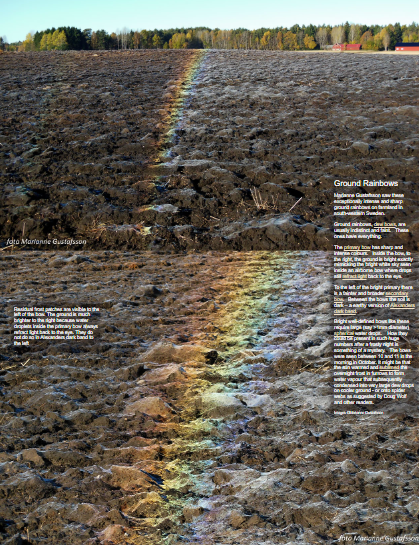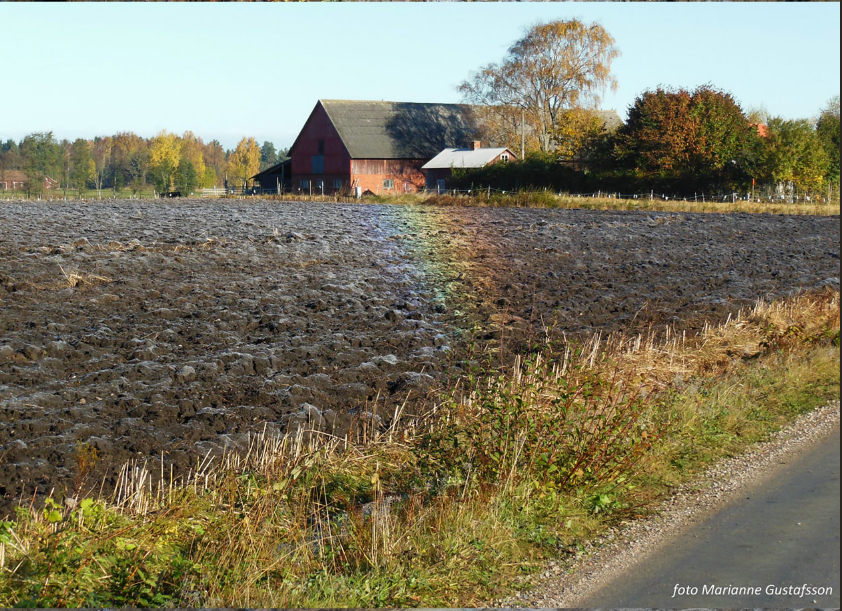OPOD - Ground Rainbows
OPOD - Ground Rainbows: A Phenomenon of Intense Beauty
Ground rainbows, also known as dew bows, are a fascinating atmospheric optics phenomenon that often appear faint and indistinct. However, there are instances when these rainbows display exceptional intensity and sharpness, captivating the eyes of those fortunate enough to witness them. One such instance was captured by Marianne Gustafsson on farmland in south-western Sweden, where she observed ground rainbows that possessed an extraordinary level of detail and vibrancy.
The primary bow in these ground rainbows exhibited remarkably sharp and intense colors, evoking a sense of wonder and awe. What makes these rainbows even more intriguing is the presence of bright ground inside the bow, mirroring the appearance of a bright white sky observed within an airborne rainbow. This phenomenon occurs when water droplets in the air refract light back to the observer's eye. In this case, the ground itself seemed to be reflecting and refracting light, creating a visually striking effect.
Adjacent to the primary bow, on its left side, a fainter and broader secondary bow could be seen. The space between the two bows appeared dark, resembling an earthy version of Alexander's dark band. These bright and well-defined bows are typically formed by spherical water droplets with a diameter larger than 1mm. However, the presence of such a large number of these droplets after a frosty night raises intriguing questions about their origin and formation.
The ground rainbows observed by Gustafsson were sighted between 10 and 11 in the morning during the month of October. One possible explanation for the presence of these large water droplets is that the sun's warmth caused the overnight frost to sublime, transforming it into water vapor. This vapor might have subsequently condensed into very large dew drops on the cooler ground or even onto spider webs, as suggested by Doug Wolf and other readers. However, the exact mechanism behind the formation of these droplets remains a mystery.
In the captivating images captured by Gustafsson, residual frost patches can be observed to the left of the bow. These patches serve as a visual reminder of the cold conditions that preceded the appearance of the ground rainbows. Interestingly, the ground appears significantly brighter to the right of the primary bow. This brightness can be attributed to the water droplets within the bow, which have the unique property of refracting light back to the observer's eye. In contrast, these droplets do not exhibit the same refractive behavior in Alexander's dark band on the left side of the bow.
The phenomenon of ground rainbows provides a captivating glimpse into the intricate beauty of atmospheric optics. While faint and indistinct ground rainbows are more commonly observed, the intense and sharp ones, such as those documented by Marianne Gustafsson, offer a rare treat for those who appreciate the wonders of nature. The presence of large spherical water droplets in such significant numbers after a frosty night presents an intriguing puzzle that continues to perplex scientists and enthusiasts alike.
In conclusion, ground rainbows are a remarkable manifestation of atmospheric optics, and their exceptional intensity and sharpness are a sight to behold. As we continue to unravel the mysteries behind their formation, we are reminded of the endless marvels that nature has to offer. Whether it be the play of light on water droplets or the interplay between sunlight and frost, these phenomena serve as a testament to the beauty and complexity of our natural world.

Ground Rainbows
Marianne Gustafsson saw these exceptionally intense and sharp ground rainbows on farmland in south-western Sweden.
Ground rainbows, dew bows, are usually indistinct and faint. These ones have everything.
The primary bow has sharp and intense colours. Inside the bow, to the right, the ground is bright exactly mimicking the bright white sky seen inside an airborne bow where drops still refract light back to the eye.
To the left of the bright primary there is a fainter and broader secondary bow. Between the bows the soil is dark – a earthy version of Alexanders dark band.
Bright well-defined bows like these require large (say >1mm diameter) spherical water drops. How they could be present in such huge numbers after a frosty night is something of a mystery. The bows were seen between 10 and 11 in the morning in October. It might be that the sun warmed and sublimed the overnight frost in furrows to form water vapour that subsequently condensed into very large dew drops on cooler ground - or onto spider webs as suggested by Doug Wolf and other readers.
Images ©Marianne Gustafsson
Residual frost patches are visible to the left of the bow. The ground is much brighter to the right because water droplets inside the primary bow always refract light back to the eye. They do not do so in Alexanders dark band to the left

Note: this article has been automatically converted from the old site and may not appear as intended. You can find the original article here.
Reference Atmospheric Optics
If you use any of the definitions, information, or data presented on Atmospheric Optics, please copy the link or reference below to properly credit us as the reference source. Thank you!
-
<a href="https://atoptics.co.uk/blog/opod-ground-rainbows/">OPOD - Ground Rainbows</a>
-
"OPOD - Ground Rainbows". Atmospheric Optics. Accessed on November 23, 2024. https://atoptics.co.uk/blog/opod-ground-rainbows/.
-
"OPOD - Ground Rainbows". Atmospheric Optics, https://atoptics.co.uk/blog/opod-ground-rainbows/. Accessed 23 November, 2024
-
OPOD - Ground Rainbows. Atmospheric Optics. Retrieved from https://atoptics.co.uk/blog/opod-ground-rainbows/.